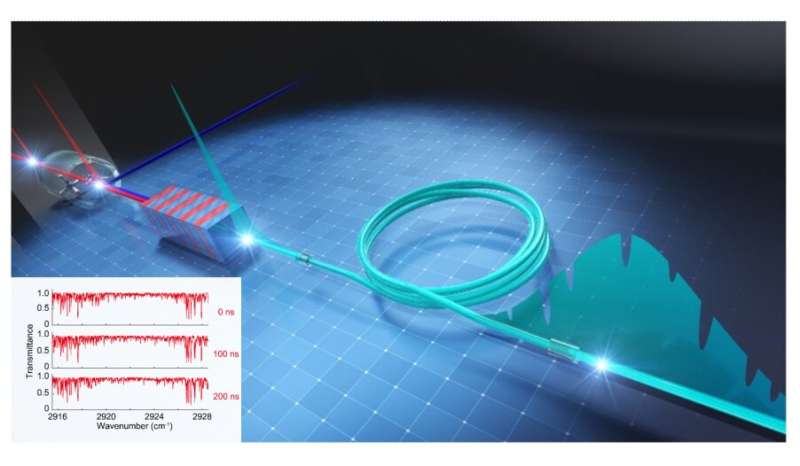This article has been reviewed according to Science X's editorial process and policies. Editors have highlighted the following attributes while ensuring the content's credibility:
fact-checked
peer-reviewed publication
trusted source
proofread
Detecting molecular vibration information faster and better by 'stretching' time

Infrared spectroscopy is a noninvasive tool used to identify unknown samples and known chemical substances. It is based on how different molecules interact with infrared light. You may have seen this tool at airports, where they screen for illicit drugs. The technique has many applications: liquid biopsy, environmental gas monitoring, contaminant detection, forensic analyses, exoplanet searches, etc.
However, traditional infrared spectroscopy methods provide low (temporal) resolution data. They are usually only applied for static samples because spectral data acquisition is a slow process. Detecting fast-changing phenomena requires multiple quick measurements.
Thanks to Prof. Ideguchi and his team at the University of Tokyo, it is now possible to obtain high-speed and high-resolution spectral data. The team developed a technique for upconversion time-stretch infrared spectroscopy (UC-TSIR), which can measure infrared spectra with 1,000 spectral elements at a rate of 10 million spectra per second.
Atoms in a molecule are bound together—like spheres with stiff springs connecting them. Shine infrared light (2–20 µm wavelength) on a substance and it absorbs infrared energy, and the "springs" vibrate. The range of vibrational motions depends on the structure of the molecule. So, we can identify and infer the properties of the substance by detecting the range of wavelengths absorbed by the substance—its absorption spectra.
"With recent improvements in the capability of analyzing spectra using machine learning and other techniques, it is essential for infrared spectroscopy methods to acquire a large amount of molecular vibration information rapidly. We wanted to develop the infrared spectroscopy method to achieve that," said Prof. Ideguchi.
Conventional time-stretch infrared spectroscopy data has fewer measurable spectral elements (~30) because the instruments work in the infrared region, where optical technology is currently limited. "UC-TSIR breaks the limit by converting infrared pulses containing molecular vibration information into near-infrared pulses with wavelength conversion techniques (upconversion) and temporally stretching and detecting the pulses in the near-infrared region," said Dr. Hashimoto.
Compared to conventional methods, UC-TSIR provides over 30-fold more spectral elements and 400 times better spectral resolution. The UC-TSIR can trace high-speed phenomena such as the combustion of gaseous molecules and irreversible chemical reactions of biomolecules at a high temporal resolution.
In theory, the concept sounds simple and easy to implement; but it was far from that. "We carefully selected optical elements and adjusted the parameters through trial and error. Even after building the setup, we dealt with various spectral distortions caused by unwanted nonlinear optical effects and insufficient time stretching. We were overjoyed when we finally saw clear infrared absorption spectra after dealing with those issues," said Dr. Hashimoto. "Nanosecond- or microsecond-scale ultra-fast continuous infrared spectral measurements by UC-TSIR can solve problems unresolved by conventional spectroscopy methods."
The work is published in the journal Light: Science & Applications.
More information: Kazuki Hashimoto et al, Upconversion time-stretch infrared spectroscopy, Light: Science & Applications (2023). DOI: 10.1038/s41377-023-01096-4
Journal information: Light: Science & Applications
Provided by University of Tokyo





















